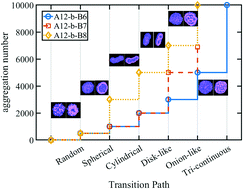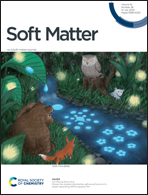Self-assembly of linear diblock copolymers in selective solvents: from single micelles to particles with tri-continuous inner structures†
Abstract
Large-scale dissipative particle dynamics (DPD) simulations have been performed to investigate the self-assembly of over 20 000 linear diblock copolymer chains in a selective solvent. Specifically, we found that the transition from spherical to cylindrical vesicles and in turn to disk-like and onion-like vesicles, and finally to tri-continuous spherical particles is mainly due to the increase in the aggregation number. In addition, the structures with large aggregation numbers are formed through the fusion of smaller aggregates and the length of the corona block of the block copolymer plays a critical role in the resulting morphology. Furthermore, our simulations indicate that the very larger amount of polymer in our simulation is the key to the observation of a state of dynamic equilibrium between free chains and aggregates in solution, as well as the formation of more complex structures from linear diblock copolymers in selective solvents. Overall, this study paves the way for future coordinated experimental/computational studies on the formation of nanoparticles with complex morphologies from diblock copolymers, an area of great scientific and industrial interest.



 Please wait while we load your content...
Please wait while we load your content...